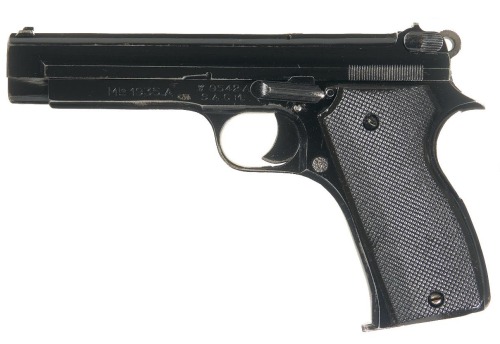





SIG P210
In 1947 the Swiss Army began to replace its Lugers with a more modern pistol. The SIG P210, designated the Ordnanzpistole 49 in Swiss service, has a reputation for being one of the finest and most accurate service pistols ever adopted.
In 1937, Schweizerische Industrie Gesellschaft (SIG) purchased the patent rights to a handgun design developed by Charles Petter. Petter, a Swiss-born soldier who served as an officer in both the Swiss Army and the French Foreign Legion, designed the gun in the early 1930s and patented it in 1935. Petter was the director of the French small arms company Societe Alsacienne de Constructions Mecaniques (SACM). In 1937, the French army adopted his pistol as the Modèle 1935A (see images #6 & #7). SIG’s development of the pistol was slow, it wasn’t until the Swiss Army again became interested in a new service pistol, in the second half of the 1940s, that development was completed.
Petter was influenced by the short recoil action and locking system used by John Browning’s Colt M1911. Petter’s design, however, utilised two links at the rear of the barrel rather than Browning’s one and a captive recoil spring. The French pistol abandoned the Colt’s grip safety and also chambered the 7.65×20mm Longue cartridge, feeding from an eight round, single stack magazine. The SIG also fed from an eight round magazine but chambered both 9x19mm, 7.65x21mm and .22LR.

French Modèle 1935A, designed by Charles Petter (source)
SIG did not immediately begin production of Petter’s pistol, instead SIG made a series of several prototypes. When the Swiss Army began pistol trials in the early 1940s, SIG offered prototypes with both single stack and double stacked magazines. The Swiss eventually decided to adopt a single stack design believing the wider grip of double stack pistols negatively affected accuracy.
The Swiss military tested the prototypes from SIG against the Versuchsmodells (Experimental models) from Waffenfabrik (W+F) Bern. These included the Pistole 43 series of guns based upon FN’s GP35/High Power. When these were rejected Bern offered a second pistol, the Pistole 47, which used an innovative gas-delayed blowback action. SIG’s entry went on to beat both of W+F Bern’s prototypes. The Walther PP and P38 were also tested, as was the excellent Polish Pistolet wz/35 (Radom).
The SIG commercial designation for the pistol was initially SP47/8, this changed to P210 in 1957 to match SIG’s nomenclature, the commercial pistol lacks the military version’s loaded chamber indicator. The Swiss military adopted the SP47/8 as the Ordnanzpistole 49 or Selbstladepistole Modell 49. The Modell 49 remained in service until the Pistole 75 (P220) began replacing it. Some remain reportedly in service with the Swiss military and police force.
For the Swiss accuracy was key, in early trials the Luger out performed the SIG, however, the P210 is an extremely accurate pistol. The P210 owes it′s accuracy to its fine manufacture, its long sight radius and its slide riding on rails inside the frame rails, rather than outside. The P210 is machined from solid steel forgings and each pistol is hand fitted.

Disassembled SIG P210 (source)
Compared to the
Modèle 1935A,
the SIG shifted the position of the manual safety from the slide to
to a more ergonomic position on the frame under the user’s right thumb. The slide release, however, is less ergonomically positioned because of this change. The SIG also has a spur-style hammer as opposed to the Modèle 1935A’s rounded hammer. The SIG has a milled cutout below the barrel rather than a linkage used by Petter’s original design.
The Pistole 49 is short-recoil operated with a locked-breech, it feeds from an eight round, single stack magazine but unlike the Modèle 1935A, the SIG has a heel rather than thumb magazine release. Interestingly, this was also a move away from the thumb release found on the Swiss Army’s Lugers. The large heel release is easier to manipulate in cold weather or when wearing gloves. The Swiss military’s Pistole 49′s have a matte finish and initially had wooden grips (see image #1 & #5) before transitioning to plastic grips (see image #2).
In 1947 the Danish Army became interested in SIG’s pistol, adopting it as the
Pistol M/49. The M/49 remains in service with the Danish Army after almost 70 years, although it is now being replaced by Heckler & Koch’s USP9 SD. Additionally the West German police (the Bundesgrenzschutz) also purchased 5,000 P210-4.
Sources:
Charles Petter’s Swiss Patent, #185452, 25/02/1936 (source)
Handguns of the World, E.C. Ezell, (1981)
SIG P210, World Guns, (source)
If you enjoy the content please consider supporting Historical Firearms through Patreon!
 vince-m88 liked this
vince-m88 liked this  utreijgyh liked this
utreijgyh liked this kmac651 liked this
tyrandfenrir reblogged this from red-faced-wolf
red-faced-wolf reblogged this from saskjeeper
 42mide liked this
42mide liked this saskjeeper reblogged this from spoilinforafight
 swhyte998 liked this
swhyte998 liked this  isai-212 liked this
isai-212 liked this  forsakenidol liked this
forsakenidol liked this gudmartin reblogged this from spoilinforafight
baileyart liked this
 teddyshrew liked this
teddyshrew liked this  thekiltedprivateer reblogged this from spoilinforafight
thekiltedprivateer reblogged this from spoilinforafight  thekiltedprivateer liked this
thekiltedprivateer liked this spoilinforafight reblogged this from call-me-remi
qupritsuvwix reblogged this from shmurnoff
qupritsuvwix liked this
 calltaker9871 liked this
calltaker9871 liked this el-mas-feu liked this
 blzdbongman reblogged this from our2ndamemdmentblog
blzdbongman reblogged this from our2ndamemdmentblog  blzdbongman liked this
blzdbongman liked this  ostwind reblogged this from our2ndamemdmentblog
ostwind reblogged this from our2ndamemdmentblog  ostwind liked this
ostwind liked this 86strokerlx liked this
 arikaido liked this
arikaido liked this axa1008 liked this
 harrytampacist liked this
harrytampacist liked this bachatanero liked this
hahandyouthoughtiwasnormal-blog reblogged this from our2ndamemdmentblog
hahandyouthoughtiwasnormal-blog liked this
 oralmaster6969 liked this
oralmaster6969 liked this  fookpeng liked this
fookpeng liked this  wareaglegonzo liked this
wareaglegonzo liked this  73pirates liked this
73pirates liked this  der58 liked this
der58 liked this  batkdmalik reblogged this from our2ndamemdmentblog
batkdmalik reblogged this from our2ndamemdmentblog  batkdmalik liked this
batkdmalik liked this historicalfirearms posted this
- Show more notes
